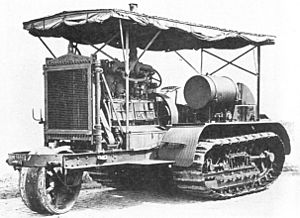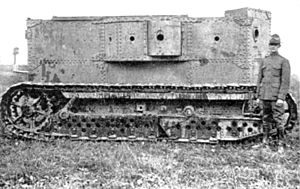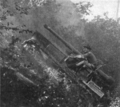Holt Manufacturing Company facts for kids
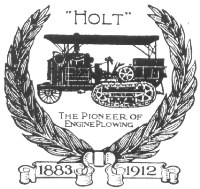
The company's first logo as it appeared on a 25th anniversary sales brochure
|
|
| Private company | |
| Industry | Agricultural machinery, construction |
| Fate | Merged with C. L. Best Tractor Company |
| Predecessor | Holt Bros. Manufacturing |
| Successor | Caterpillar Tractor Company |
| Founded | 1883 (Stockton Wheel Service) January 7, 1892 (Holt Manufacturing Company) Stockton, California, United States |
| Founder | Ames Holt, Benjamin Holt Charles Holt, William Holt |
| Defunct | April 15, 1925 |
| Headquarters |
,
United States
|
|
Area served
|
United States |
|
Key people
|
Benjamin Holt, founder and President; Charles Holt, founder; Clarence Leo Best |
|
Number of employees
|
2,100 (1918) |
| Subsidiaries | Aurora Engine Company Best Manufacturing Company Canadian Holt Company, Limited Holt Caterpillar Company Holt Manufacturing Company Houser and Haines Manufacturing Company Stockton Wheel Co. |
The Holt Manufacturing Company was an important American company that made farm and construction machines. It started in 1883 as Stockton Wheel Service in Stockton, California. The company was officially named Holt Manufacturing Company in 1892 by Benjamin Holt. He is famous for inventing the first successful "caterpillar" or continuous track tractor.
By the early 1900s, Holt Manufacturing Company was a top maker of combine harvesters and steam traction engines in the US. Their machines were used all over the world. During World War I, their tractors became very important for the military. They helped pull heavy artillery and supplies for the Allies. Holt tractors also played a role in developing early military tanks.
After the war, the company faced challenges. It merged with its main competitor, C. L. Best Tractor Company, in 1925. Together, they formed the Caterpillar Tractor Company, which is now a huge global company.
Contents
Company Beginnings
The Holt family started their business making wooden wagon wheels. Benjamin Holt's brother, Charles, began C. H. Holt and Co. in San Francisco in 1864. Later, Benjamin joined his brothers to help with the family business.
In 1892, Charles, Benjamin, and Frank Holt officially started the Holt Bros. Company. They also created the Holt Manufacturing Company. They built a factory in Stockton, California, which was a great location. Stockton could be reached by ships, and its hot weather helped dry wood for their products. The factory was very modern for its time.
Benjamin Holt was very good at inventing. He focused on making new farm equipment. He and Charles eventually took over the business from their other brothers. Charles managed the business side, while Benjamin focused on making the machines.
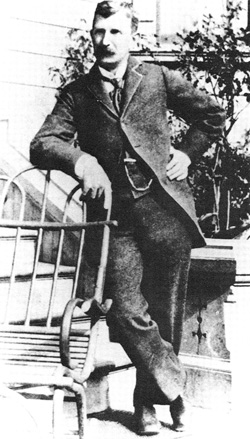
The Stockton Wheel Company first made wagon wheels and carriage bodies. They even made huge 10-foot wheels for logging redwood trees.
Farm Machines and Tractors
In the late 1800s, many companies tried to build better farm machines. Holt started making horse-drawn combine harvesters in the 1890s. These machines could cut and thresh grain in one go, saving farmers a lot of time. Holt's combines used flexible chain belts instead of gears, which was a key improvement.
Later, Holt moved to steam-powered machines. These early steam tractors were very heavy. Some weighed as much as 48,000 pounds! They were popular because they could harvest large fields much cheaper than horses. But their weight caused problems, especially in soft, muddy ground.
Benjamin Holt tried to solve this by making the wheels bigger and wider. But this made the tractors too large and hard to manage. So, he started experimenting with a new idea: tracks.
The First Crawler Tractor
Many people had tried to make machines with tracks, but none worked well. In 1904, Benjamin Holt tried something new. He took the wheels off a 40-horsepower steam tractor and put wooden tracks on chains instead.
On November 24, 1904, he tested this new machine. It successfully plowed through the muddy land of Roberts Island in California. The company photographer reportedly said it "crawled like a caterpillar". Benjamin Holt loved the name, saying, "Caterpillar it is. That's the name for it!"
This invention was a game-changer. It allowed farmers to work on soft, wet land that was impossible to farm before. Holt started making these "Caterpillar" tractors. The first steam-powered crawler tractors sold for $5,500. By 1915, Holt had sold nearly 2,000 Caterpillar crawlers in over 20 countries.
Gasoline Engines
Steam engines were powerful but had many downsides. They were huge, heavy, and needed a large crew to operate. They also used a lot of water and fuel like coal or wood.
In 1906, Pliny E. Holt, Benjamin's nephew, became president of the Aurora Engine Company, a Holt subsidiary. This company started making gasoline engines. Gasoline engines were much smaller and lighter. They also produced more power for their weight. This made tractors cheaper and easier to use. Holt's most popular gasoline tractor was the Model 75. It weighed 24,000 pounds and had a 75-horsepower engine.
Expanding to Illinois
Holt wanted to be closer to the big farming areas in the Midwest. In 1909, Pliny Holt found a factory for sale in East Peoria, Illinois. It belonged to a bankrupt company called Colean Manufacturing Co. Pliny bought the factory for a good price.
On January 12, 1910, the "Holt Caterpillar Company" was officially formed in Illinois and California. The East Peoria factory became Holt's eastern manufacturing plant. It quickly became very successful. Just two years later, it employed 625 people and was sending tractors to Argentina, Canada, and Mexico.
Los Angeles Aqueduct Project
In 1909, engineers building the 233-mile-long Los Angeles Aqueduct needed strong machines. They bought one of Holt's Model 70-120 tractors. It easily pulled 30 tons of supplies up a steep hill in the Mojave Desert. They were so impressed that they ordered 26 more tractors. This project gave Holt tractors a lot of fame and boosted sales.
Merging Companies
In 1913, Holt brought all its different companies together under the name Holt Manufacturing Company. This included the Stockton Wheel Co., Best Manufacturing Company, and Holt Caterpillar Company. This made the company stronger and more organized.
Challenges After World War I
Holt tractors were widely used in World War I. Their strength and reliability became well known. Benjamin Holt learned how to get big government contracts. This helped his company grow during the war.
However, after the war, Holt faced problems. The company had expanded to meet military needs. But the tractors made for the military were too big and heavy for farmers. Also, many military tractors were brought back from Europe. This lowered prices for new equipment.
Holt's main competitor, C. L. Best Gas Tractor Company, had focused on smaller farm tractors during the war. Best had also gotten special permission to get steel for their tractors. This gave Best a big advantage in the farming market after the war.
Both Holt and Best were hurt by a nationwide economic downturn in 1920-21. This made it even harder to sell machines. Benjamin Holt died in December 1920 at age 71.
Forming Caterpillar Company
The banks that had loaned Holt money pushed the company to make changes. They brought in Thomas F. Baxter as the new CEO. Baxter first tried to make smaller tractors for farmers. Then, when a new law funded a huge highway building program, he focused on road construction equipment.
Holt and Best had spent a lot of money fighting each other in court over patents and trademarks. In 1925, investors suggested that the two companies should merge. This would make them stronger and stop the expensive lawsuits.
So, in April and May 1925, the C. L. Best company merged with Holt Caterpillar. They formed the Caterpillar Tractor Co.. Clarence Leo Best became the CEO of the new company. The new company combined the best products from both firms.
Today, Caterpillar Inc. is one of the largest companies in the world. It is still a leader in making heavy equipment. Benjamin Holt's great-grandson, Peter Holt, owns the largest Caterpillar dealership in the US, called HOLT CAT.
Early Military Uses

Before World War I, David Roberts in England tried to get the British military interested in tracked vehicles. Holt bought Roberts' patents in 1912. When the war started, the military needed powerful machines to move supplies and guns through muddy trenches. Tracked tractors were perfect for this.
Pliny Holt, Benjamin's nephew, helped the US military with their "Caterpillar" Artillery program. The British War Office tested a Holt tractor and found it great for pulling heavy loads over rough ground. They chose it as a gun-tractor. France also ordered Holt's smaller 45-horsepower model.
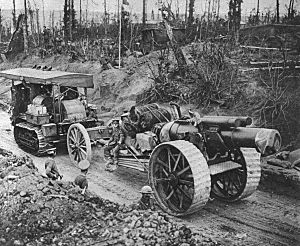
The Holt 75 model gasoline tractor became a standard military tractor. Holt couldn't make enough tractors, so other companies were allowed to build their design. Over the next four years, Holt tractors were used to pull large guns like howitzers. They also hauled long trains of supplies behind the front lines. They were very helpful in difficult terrain.
Influence on Tanks
Holt tractors were a big inspiration for the development of military tanks. Major Ernest Swinton of Britain saw how useful tracked tractors were. He suggested building a bullet-proof, tracked vehicle to fight machine guns. Holt tractors were the "inspiration for the development of the British tank."

Key figures in tank development were influenced by Holt tractors. The French military also bought Holt tractors and used them to design their own early tanks. Even the German A7V tank was based on Holt tractors captured by the Austro-Hungarian army.
By 1916, about 1,000 Holt Caterpillar tractors were used by the British in World War I. By the end of the war, the Allies used about 5,000 Holt vehicles.
US Tank Prototypes
In the US, Pliny Holt helped design and build artillery tractors based on the Caterpillar design. Holt also built a prototype tank called the Holt Gas-Electric. It used a gasoline engine to power a generator, which then drove electric motors for each track. However, this tank did not go beyond the prototype stage.
Holt also made tracked gun-carriers. These were vehicles that could carry large guns. They were designed to move quickly over rough terrain. One prototype could travel at 28 miles per hour and climb a 45-degree slope. But the war ended before these projects were finished. Self-propelled artillery became important again before World War II.
In April 1918, British Colonel Ernest Swinton visited Stockton. He publicly thanked Benjamin Holt and his workers. He recognized their huge contribution to the war effort. He called Holt the "developer of the track" that inspired the tank.
Images for kids
-
Holt Steamer No. 77, the second prototype of a crawler-track -type tractor, on a trial run demonstrating its ability to travel across the marshy peat soil of Roberts Island.
-
The Holt Caterpillar Co. factory in East Peoria, Illinois, in 1910. Tractors were assembled in place before assembly lines were introduced. Holt bought the plant from the bankrupt Colean Manufacturing Co. in 1910.
-
Two Holt 45 gas crawling-type tractors team up to pull a long wagon train in the Mojave Desert during construction of the Los Angeles Aqueduct in 1909.
-
A Holt 60-horsepower, four-cylinder valve-in-head gasoline Caterpillar (s/n 524) in 1912. The tractor was restored in the late 1960s and is the oldest surviving East Peoria-built tractor known to exist.



